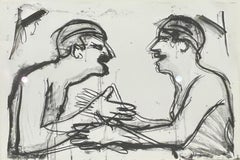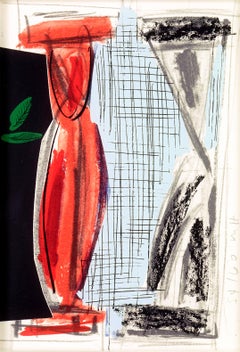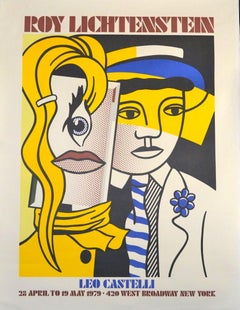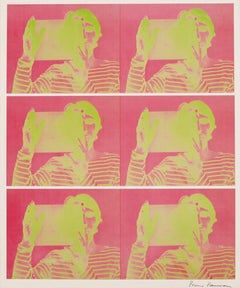Bruce Nauman More Prints
American, b. 1941
Life and work - via Wikipedia Bruce Nauman (American, b. 1941)
In the 1960s, Nauman began to exhibit his work at Nicholas Wilder's gallery in Los Angeles and in New York at Leo Castelli in 1968 along with early solo shows at the Los Angeles County Museum of Art and the Whitney Museum in 1972.
Nauman's use of neon as a medium recurs in his works over the decades. He uses neon to make allusions to the numinous connotations of light, similar to Mario Merz, who used neon to bring new life to assemblages of mundane objects. Neon also connotes the public atmosphere by the means of advertising, and in his later works he uses it ironically with private, erotic imagery as seen in his Hanged Man (1985).
His Self Portrait as a Fountain (1966) shows the artist spouting a stream of water from his mouth. At the end of the 1960s, Nauman began constructing claustrophobic and enclosed corridors and rooms that could be entered by visitors and which evoked the experience of being locked in and of being abandoned. A series of works inspired by one of the artist's dreams was brought together under the title of Dream Passage and created in 1983, 1984, and 1988. In his installation Changing Light Corridor with Rooms (1971), a long corridor is shrouded in darkness, whilst two rooms on either side are illuminated by bulbs that are timed to flash at different rates.
Since the mid-1980s, primarily working with sculpture and video, Nauman developed disturbing psychological and physical themes incorporating images of animal and human body parts, depicting sadistic allusions to games and torture together with themes of surveillance. In 1988, after a hiatus of nearly two decades focused on time-based media, he resumed his work with cast objects.to
1
1
Overall Width
to
Overall Height
to
1
1
6
688
451
202
159
2
1
1
1
1
2
1
1
2
Artist: Bruce Nauman
Fingers and Holes (Black and White)
By Bruce Nauman
Located in Hollywood, FL
Artist: Bruce Nauman
Title: Fingers and Holes (Black and White)
Size: 30 x 40 Inches
Medium: Lithograph and Screenprint
Edition: Edition of 50. AP #7/10
Year: 1994
Notes: Hand Signed, Dated and Numbered by the Artist in Pencil. Printed by Gemini Gel #36.34. From the collection of Brook Alexander Gallery, NYC.
Fingers and Holes, a captivating artistic exploration initiated by Bruce Nauman (American, born 1941), originated from a unique challenge he set for himself. Using his non-dominant hand, he drew his right hand, and vice versa, meticulously annotating each sketch with the count of holes formed between the fingers. This seemingly simple endeavor evolved into a profound study of algebraic topology, a mathematical field investigating fundamental properties of distorted objects, such as solids and voids. Nauman ingeniously translated his anatomical sketches into this abstract language.
In this realm of mathematical inquiry, seemingly dissimilar objects transform into one another. A coffee cup and a doughnut, for instance, are considered equivalents due to their shared characteristic of having an unbroken surface surrounding a single "hole," a concept known as homeomorphisms. Nauman's deep dive into topology revealed connections between disparate elements, encapsulated in his statement, “Things that don’t look alike morphose one into another.”
However, Fingers and Holes goes beyond mathematical intricacies. It delves into the realm of transformation—topological, visual, and linguistic. The iconic "three fingers, one hole" gesture, a symbol of sexual intercourse in what Nauman referred to as "kids’ sign language," served as a pivotal motif. This gesture reappeared in various forms within the series, including daisy chain formations and overlays on clowns' handshakes, which Nauman identified through his exploration.
The clowns in Nauman’s work epitomize ambiguity, embodying a spectrum from humor to threat. Their double handshakes, simultaneously obsequious and aggressive, mirror the complexities of human interactions. Nauman found inspiration in this ambiguity, appreciating the clowns for their enigmatic nature. By integrating the "three fingers, one hole" motif into the handshake of his clown prints...
Category
1990s Contemporary Bruce Nauman More Prints
Materials
Lithograph, Screen
Bruce Nauman: Holograms, Videotapes, and Other Works"), Leo Castelli
By Bruce Nauman
Located in New York, NY
Bruce Nauman
Untitled (2-color lithograph, published in conjunction with the exhibition "Bruce Nauman: Holograms, Videotapes, and Other Works"), Leo Castelli, 1969
Lithograph
24 x 20...
Category
1960s Pop Art Bruce Nauman More Prints
Materials
Lithograph
Related Items
Two Columns (framed): colorful pop art abstracted Greek pillars Micheal Hurson
By Michael Hurson
Located in New York, NY
Pop art scene of abstracted Greek pillars and green leaves. Drawings in black and white, pale blue, red and grey compose this colorful print. Layers of p...
Category
1980s Contemporary Bruce Nauman More Prints
Materials
Lithograph, Screen
$1,100
H 9.75 in W 7.5 in D 0.75 in
Lichtenstein Exhibition Poster - Leo Castelli Gallery
Located in Roma, IT
Lichtenstein Exhibition Poster is a very colorful poster realized in occasion of the artist's exhibition at Leo Castelli Gallery New Yor...
Category
1970s Pop Art Bruce Nauman More Prints
Materials
Offset, Lithograph
$986 Sale Price
40% Off
H 35.83 in W 25.79 in D 0.08 in
Original Andy Warhol Brillo Pasadena Art Museum serigraph vintage poster
By Andy Warhol
Located in Spokane, WA
Original serigraph: Andy Warhol Brillo soap pads. Artist: Andy Warhol. Size 26" x 30" Year: 1970. Archival linen-backed original serigraph ready to frame.
Warhol's Billo ...
Category
1970s Pop Art Bruce Nauman More Prints
Materials
Screen
$2,498
H 30 in W 26 in D 0.3 in
Untitled from In the Bottom of My Garden (Plate 17)
By Andy Warhol
Located in Washington, DC
Artist: Andy Warhol
Title: Untitled (Plate 17)
Portfolio: In the Bottom of My Garden
Medium: Offset lithograph and watercolor on paper
Date: 1956
Frame Size: 15 3/4" x 18 3/8"
Sheet ...
Category
1950s Pop Art Bruce Nauman More Prints
Materials
Lithograph
Original GEMINI Zodiac by Funky Features Psychedelic 1960s vintage poster
Located in Spokane, WA
Original 1960s Gemini Zodiac Poster by Dick Moore – Vintage Psychedelic Astrology Wall Art. Bright colors, never framed. In very fine condition, be...
Category
1960s Pop Art Bruce Nauman More Prints
Materials
Lithograph
$250
H 28.75 in W 22.6 in D 0.2 in
Düsseldorf (German Cities) by Dieter Roth monuments vintage postcard light blue
By Dieter Roth
Located in New York, NY
Düsseldorf (German Cities), 1970
24 x 33.8 in. / 61 x 86 cm
Screen print in one color on offset lithograph, black on white card. “for Paul” written in pencil lower middle. Signed and...
Category
1960s Abstract Bruce Nauman More Prints
Materials
Lithograph, Screen
Untitled from In the Bottom of My Garden (Plate 1)
By Andy Warhol
Located in Washington, DC
Artist: Andy Warhol
Title: Untitled (Plate 1)
Portfolio: 1956 In the Bottom of My Garden
Medium: Offset lithograph and watercolor on paper
Date: 1956
Frame Size: 15 3/4" x 18 3/8"
Sh...
Category
1950s Pop Art Bruce Nauman More Prints
Materials
Lithograph
"Statue of Liberty" signed screen print and collage by Robert Rauschenberg
By Robert Rauschenberg
Located in Boca Raton, FL
"Statue of Liberty" screen print and collage by Robert Rauschenberg from the "New York, New York" portfolio published by the New York Graphic Society. Signed Rauschenberg...
Category
1980s Contemporary Bruce Nauman More Prints
Materials
Lithograph, Screen
$9,000
H 34.5 in W 23.5 in
OG SLICK - SLICKMAU5 2020 - DEADMAU5 X SLICK - Edition 81 of 100
Located in Dallas, TX
SLICKMAU5 2020 DEADMAU5 X SLICK Black Hole Edition Signed Poster. Edition: 81/100
Size: 24 Inches H x 24 Inches W
SOLD OUT - Edition
Brand new in perfect condition.
Slick’s work ha...
Category
2010s Pop Art Bruce Nauman More Prints
Materials
Lithograph, Screen
$796 Sale Price
20% Off
H 24 in W 24 in D 1 in
Agam Silkscreen Mod Judaica Lithograph Hand Signed Israeli Kinetic Op Art Print
By Yaacov Agam
Located in Surfside, FL
Yaacov Agam
Israeli (b. 1928)
Hand signed, not individually numbered but from edition of 180. I can include a copy of the title sheet with the edition size and his signature if you r...
Category
1980s Op Art Bruce Nauman More Prints
Materials
Lithograph, Screen
Best Men
By John Baldessari
Located in Calabasas, CA
Artist: Johns Baldessari
Title: Best Men
Year: 2017
Medium: Screenprint on Arches 88 paper
Edition: 50; signed, dated and numbered in pencil
Sheet: 32 1/2 x 28 inches (82.5 x 71.1 cm...
Category
2010s Contemporary Bruce Nauman More Prints
Materials
Screen
Untitled from In the Bottom of My Garden (Plate 5)
By Andy Warhol
Located in Washington, DC
Artist: Andy Warhol
Title: Untitled (Plate 5)
Portfolio: 1956 In the Bottom of My Garden
Medium: Offset lithograph and watercolor on paper
Date: 1956
Frame Size: 15 3/4" x 18 3/8"
Sh...
Category
1950s Pop Art Bruce Nauman More Prints
Materials
Lithograph
Previously Available Items
Caned Dance
By Bruce Nauman
Located in New York, NY
A very good impression of this color lithograph on Arches. Signed, dated and numbered 64/100 in pencil by Nauman. Printed by Cirrus Editions, Ltd., Los Angeles, with the blind stamp ...
Category
1970s Contemporary Bruce Nauman More Prints
Materials
Color, Lithograph
"Bruce Nauman: Holograms, Videotapes, and Other Works"), Leo Castelli
By Bruce Nauman
Located in New York, NY
Bruce Nauman
Untitled (2-color lithograph, published in conjunction with the exhibition "Bruce Nauman: Holograms, Videotapes, and Other Works"), Leo Castelli, 1969
Lithograph
24 x 20...
Category
1960s Pop Art Bruce Nauman More Prints
Materials
Lithograph
H 24 in W 20 in D 0.25 in
Bruce Nauman more prints for sale on 1stDibs.
Find a wide variety of authentic Bruce Nauman more prints available for sale on 1stDibs. If you’re browsing the collection of more prints to introduce a pop of color in a neutral corner of your living room or bedroom, you can find work that includes elements of yellow and other colors. You can also browse by medium to find art by Bruce Nauman in lithograph, drypoint, engraving and more. Much of the original work by this artist or collective was created during the 20th century and is mostly associated with the contemporary style. Not every interior allows for large Bruce Nauman more prints, so small editions measuring 18 inches across are available. Customers who are interested in this artist might also find the work of John Baldessari, Jasper Johns, and Samuel Field. Bruce Nauman more prints prices can differ depending upon medium, time period and other attributes. On 1stDibs, the price for these items starts at $4,500 and tops out at $37,000, while the average work can sell for $10,620.




